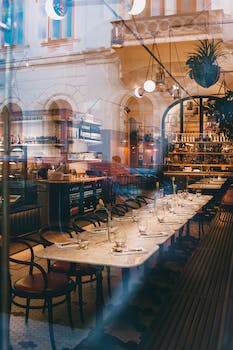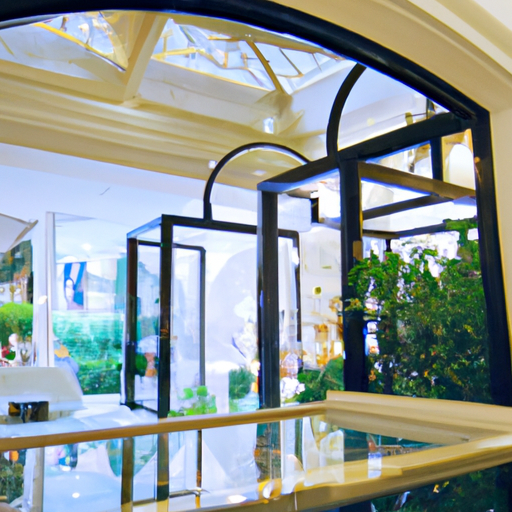Incorporating Timeless Design Elements for a Luxurious Architectural Aesthetic
Luxury is a term that has been associated with architecture for centuries. It is a concept that transcends time and space, and it is often the ultimate goal for architects and designers when creating a space. The idea of luxury in architecture is not just about opulence and extravagance, but rather about creating a sense of comfort, elegance, and sophistication. In order to achieve this, architects must incorporate timeless design elements that evoke a sense of luxury and elevate the overall aesthetic of the space.
One of the most important aspects of creating a luxurious architectural aesthetic is the use of high-quality materials. This not only ensures durability and longevity but also adds a sense of refinement and sophistication to the space. Materials such as marble, granite, and hardwood are often associated with luxury due to their natural beauty and ability to age gracefully. These materials can be used in various ways, such as flooring, countertops, and wall cladding, to create a cohesive and elegant design.
Another key element in creating a sense of luxury through architecture is the use of symmetry and balance. This can be achieved through the careful arrangement of architectural elements, such as windows, doors, and columns, as well as the overall layout of the space. Symmetry and balance create a sense of harmony and order, which is often associated with luxury and sophistication. This can be seen in many iconic examples of luxurious architecture, such as the Palace of Versailles and the Taj Mahal, where symmetry and balance are used to create a sense of grandeur and opulence.
In addition to symmetry and balance, the use of proportion and scale is crucial in creating a luxurious architectural aesthetic. Proportion refers to the relationship between the size of different elements within a space, while scale refers to the overall size of the space in relation to its surroundings. By carefully considering proportion and scale, architects can create spaces that feel grand and impressive without being overwhelming or ostentatious. This can be achieved through the use of high ceilings, large windows, and spacious rooms, which create a sense of openness and grandeur.
Lighting is another essential element in creating a sense of luxury through architecture. The strategic use of natural and artificial light can dramatically enhance the overall aesthetic of a space, creating a sense of warmth, comfort, and elegance. Natural light can be maximized through the use of large windows, skylights, and glass doors, while artificial lighting can be used to highlight architectural features and create a sense of ambiance. The use of layered lighting, which combines ambient, task, and accent lighting, can also help to create a sense of depth and dimension within a space.
Finally, the incorporation of art and decorative elements can greatly contribute to the creation of a luxurious architectural aesthetic. This can include the use of sculptures, paintings, and other forms of artwork, as well as decorative moldings, ornate fixtures, and intricate detailing. These elements not only add visual interest and beauty to a space but also serve to elevate the overall design and create a sense of refinement and sophistication.
In conclusion, creating a sense of luxury through architecture requires the careful consideration and incorporation of timeless design elements, such as high-quality materials, symmetry and balance, proportion and scale, lighting, and art and decorative elements. By skillfully combining these elements, architects can create spaces that exude elegance, sophistication, and comfort, ultimately achieving the desired luxurious aesthetic.
Blending Natural Materials and Modern Technology for High-End Living Spaces

Luxury living spaces are no longer just about opulence and grandeur; they are now about creating a harmonious blend of natural materials and modern technology to provide a comfortable, sustainable, and aesthetically pleasing environment. This fusion of elements not only enhances the visual appeal of a space but also contributes to the overall well-being of its occupants. In this article, we will explore how architects and designers can create a sense of luxury through the thoughtful integration of natural materials and cutting-edge technology in high-end living spaces.
One of the key aspects of creating a luxurious living space is the use of natural materials. These materials, such as wood, stone, and marble, have been used in architecture for centuries and continue to be popular choices for high-end homes. The use of natural materials not only adds a touch of elegance and sophistication to a space but also provides a connection to nature, which has been proven to have a positive impact on our mental and physical well-being. Moreover, natural materials are often more sustainable and eco-friendly than their synthetic counterparts, making them an ideal choice for environmentally conscious homeowners.
To create a seamless blend of natural materials and modern technology, architects and designers must carefully consider the functionality and aesthetics of each element. For instance, incorporating smart home technology into a space with natural materials can be achieved by discreetly integrating devices and systems into the design. This can include hidden speakers, concealed lighting, and even touch-sensitive surfaces that control various aspects of the home. By doing so, the technology becomes an integral part of the space without detracting from the beauty of the natural materials.
Another way to create a sense of luxury through architecture is by incorporating biophilic design principles. Biophilic design is an approach that seeks to connect people with nature by incorporating natural elements, such as plants, water, and natural light, into the built environment. This can be achieved through the use of large windows and skylights, indoor gardens, and water features. By incorporating biophilic design elements into a space, architects and designers can create a calming and restorative environment that promotes well-being and reduces stress.
In addition to biophilic design, architects and designers can also create a sense of luxury by incorporating sustainable and energy-efficient technologies into their projects. This can include solar panels, green roofs, and energy-efficient appliances. By incorporating these technologies, homeowners can enjoy the benefits of a luxurious living space while also reducing their environmental impact and energy costs.
Finally, the use of innovative materials and construction techniques can also contribute to the creation of luxurious living spaces. For example, the use of 3D-printed components and modular construction methods can allow for unique and customizable designs that cater to the specific needs and preferences of the homeowner. Additionally, these techniques can also reduce construction waste and promote sustainability.
In conclusion, the integration of natural materials and modern technology in high-end living spaces can create a sense of luxury that is both visually appealing and beneficial to the well-being of its occupants. By carefully considering the functionality and aesthetics of each element, architects and designers can create spaces that are not only beautiful but also sustainable and comfortable. Through the incorporation of biophilic design principles, energy-efficient technologies, and innovative construction techniques, luxury living spaces can become a harmonious blend of nature and technology that promotes a higher quality of life for those who inhabit them.
Exploring the Role of Proportion and Scale in Crafting Opulent Architectural Masterpieces
The art of creating a sense of luxury through architecture is a delicate balance of proportion, scale, and attention to detail. It is the ability to craft opulent architectural masterpieces that evoke a sense of grandeur and sophistication, while still maintaining a sense of harmony and balance. This is achieved through the careful consideration of proportion and scale, which play a crucial role in determining the overall aesthetic and atmosphere of a space.
Proportion refers to the relationship between the dimensions of different elements within a structure, while scale refers to the size of an object in relation to its surroundings. Both of these factors are essential in creating a sense of luxury, as they contribute to the overall perception of a space and its ability to evoke feelings of opulence and grandeur.
One of the most important aspects of proportion in architecture is the use of the golden ratio, a mathematical principle that has been used for centuries to create aesthetically pleasing compositions. The golden ratio, also known as the divine proportion, is a ratio of approximately 1.618:1, which is believed to create a sense of harmony and balance in design. By incorporating the golden ratio into architectural elements such as the layout of a room, the placement of windows, or the design of a staircase, architects can create a sense of order and elegance that contributes to the overall feeling of luxury.
In addition to the golden ratio, architects also rely on other proportional systems to create a sense of harmony and balance in their designs. For example, the use of modular systems, which involve dividing a space into equal parts, can help to create a sense of order and symmetry that is often associated with luxury. Similarly, the use of classical proportions, such as those found in ancient Greek and Roman architecture, can also contribute to the creation of a luxurious atmosphere.
Scale is another crucial factor in creating a sense of luxury through architecture. By manipulating the size of different elements within a space, architects can create a sense of grandeur and opulence that is difficult to achieve through other means. For example, the use of high ceilings and large windows can help to create a sense of spaciousness and grandiosity, while the use of oversized furniture and fixtures can contribute to the overall feeling of opulence.
However, it is important to note that the use of scale in architecture is not simply about making everything bigger. In fact, the most successful luxury designs often involve a careful balance of large and small elements, which work together to create a sense of harmony and proportion. For example, a large chandelier may be used to create a focal point in a room, while smaller decorative elements, such as intricate moldings or ornate door handles, can help to create a sense of detail and refinement.
Ultimately, the key to creating a sense of luxury through architecture lies in the careful consideration of proportion and scale. By paying attention to these factors, architects can craft opulent architectural masterpieces that evoke a sense of grandeur and sophistication, while still maintaining a sense of harmony and balance. Whether it is through the use of the golden ratio, classical proportions, or a careful balance of large and small elements, the art of creating luxury through architecture is a testament to the power of design to shape our perceptions and emotions.
Q&A
Question 1: What architectural elements can be used to create a sense of luxury in a building?
Answer 1: To create a sense of luxury in a building, architects can incorporate elements such as high ceilings, grand entrances, expansive windows, high-quality materials like marble and hardwood, intricate detailing, and opulent lighting fixtures.
Question 2: How can spatial planning contribute to a luxurious atmosphere in architecture?
Answer 2: Spatial planning contributes to a luxurious atmosphere by creating open, spacious layouts with well-defined functional areas, seamless indoor-outdoor connections, and ample natural light. This can be achieved through thoughtful placement of rooms, use of glass walls, and incorporating courtyards or terraces.
Question 3: What role does lighting play in creating a sense of luxury in architecture?
Answer 3: Lighting plays a crucial role in creating a sense of luxury by highlighting architectural features, setting the mood, and enhancing the overall ambiance. This can be achieved through a combination of natural light, ambient lighting, accent lighting, and decorative fixtures that complement the design and materials used in the space.
Conclusion
In conclusion, creating a sense of luxury through architecture involves the thoughtful integration of high-quality materials, innovative design, attention to detail, and the incorporation of elements that evoke opulence and sophistication. By focusing on these aspects, architects can design spaces that not only exude elegance and comfort but also provide a unique and memorable experience for the occupants.


